
In July, 1922 Nick Lucas cut two original sides for Pathe, "Picking The Guitar" and "Teasing The Frets." With these sides Nick Lucas also cut a path for generations of guitarist to come. These were the first solo jazz guitar instrumentals recorded. Without a doubt this had to be an influence on banjoists such as Eddie Lang, and also an inspiration for him to trade the banjo in for a guitar. Eddie Lang would later elaborate on Lucas' fast bass runs and be remembered as being the father of jazz guitar, this makes Nick Lucas the Grandfather of jazz guitar.
Nick Lucas was the first to trade his banjo and replace it with guitar in the big name orchestras of the day. It took a few years for Nick’s contemporaries to emulate him on the instrument. While these great guitarists were grinding their axes and become mostly sidemen, Lucas was looking past and beyond just being cast as an accompanist.
|

|
|
His recording career spanned from test cylinders for Thomas Edison in 1912 to the stereophonic age in 1980, with total disc sales in excess of 80 million copies. It is doubtful that anyone in popular music had a longer recording career, one that spanned seven decades.
It is important to remember that, though the height of his popularity came in the late 1920's, Nick Lucas' style was set by the time he moved to Chicago in 1922. Before electrical recording, before Louis Armstrong ever found his way into a recording studio, Nick Lucas had found his voice, and used it in much the same way for sixty years.
In the early days Nick’s forte was as an instrumentalist. That would change, Lucas would become one of the first popular crooners on the radio. He is actually credited as creating the "intimate style" of entertaining after beginning his vaudeville career accompanying himself with his guitar. His was the first custom-made guitar and even today one of the best selling type picks bears Nick Lucas' name. To top off these achievements, Lucas is credited with being the first band singer. All of these firsts in show business were accomplished by Nick Lucas during the "Roaring Twenties".
Born Dominic Nicholas Anthony Lucanese on August 22, 1897, the son of an Italian gardener, in Belleville, New Jersey. Dominic Nicholas Anthony Lucanese later changed his name legally to Nick Lucas. At an early age he learned how to play the guitar, mandolin and banjo. Nick's older brother Frank taught him music without any instrument, using the solfeggio system. Then taught Nick, (who was about nine-years old), to accompany him on mandolin while he,(Frank) would play accordion. According to Nick, "Frank would drag me along, and we'd play Italian christenings and weddings. We even played on street corners and in saloons, and I'd pass the hat around. I was getting a lot of experience, because the Italian people, when they get to feeling good, like to dance all night long, especially the tarantella. We played for hours and hours, and my wrists got very tired, but I was getting great practical experience that paid off years later."
Frank left home to join a vaudeville troupe, The Three Vagrants, and Nick was on his own. Nick got a job at the Johnson's Cafe in Newark, playing guitar in a band, but they thought the guitar was too soft, so he got a banjorine, which has a banjo body but the neck of a mandolin. " I got a tenor banjo and played it for a number of years, this was 1915, and at that time the tenor banjo was the instrument." After a few years at the Johnson's Café Nick went to another nightclub in Newark called the Iroquois, earning $25 a week, that was a $5 raise from the Johnson's Café.
Then after high school, Lucas formed a group called the "Kentucky Five", (which included Ted Fio Rito), and did his first vaudeville-touring on the Interstate circuit. Then Nick married Catherine Cifrodelli in 1917, and their daughter Emily was born in 1918. Nick moved his family to New York where he worked with Vincent Lopez for several months before joining the Vernon Country Club Orchestra. The group's New York debut was sponsored by Paul Whiteman and it was with the Vernon Country Club Orchestra that Nick began his recording career as a sideman in 1921. The next year, 1922, he and his brother Frank recorded for Pathe Actuelle as the Lucas Novelty Quartet and the Lucas Ukulele Trio. This is the year Nick recorded for Pathe the first guitar solo record ever made, his compositions "Picking the Guitar and "Teasing the Frets".

The Kentucky Five
|
 with the Vernon Country Club Orchestra.
with the Vernon Country Club Orchestra.
|
Nick also played guitar in a group called the Don Parker Trio, which recorded for Pathe Actuelle. He then got a job working with Sam Lanin's orchestra at the Roseland Ballroom at 51st Street and Broadway in New York City. Among the co-workers with the Lanin group were Miff Mole, Red Nichols, Arthur Fields, Rube Bloom and Tommy and Jimmy Dorsey. Besides working with Lanin's group at night he recorded with him during the day for Gennett Records, the group being called Bailey's Lucky Seven. He was making $90 a week at the Roseland, and at $20 dollars per session, doing recording work twice a day, five days a week, his income expanded to $200 dollars or more a week.
Nick was still playing the tenor banjo, which was a penetrating instrument, and in those days instead of a bass they used a tuba player and would sit at the end of the room in the recording sessions. At that time the recordings were done on thick wax cylinders, and they had to be kept warm so the needle would make a groove in it. Nick and the tuba player had to be very careful not to play too loud, because one note too loud and the needle would jump out of the groove.
|
|
|
Nick suggested to Sam Lanin to let him try the guitar instead, but Sam said, "It'll never record." But the next morning Nick brought his guitar and said, "This is just an experiment, and if it doesn't work, I've got my banjo all ready to go, put me right under the recording horn."
They recorded with Nick playing rhythm on guitar. Sam had a smile on his face and said, "You know, Nick, it's there and it's not there, but my headaches are over. I'm not having anymore troubles with the wax. From now on play the guitar."
|
|
|
|
Nick then joined the Russo-Fiorito Orchestra at the Edgewater Beach Hotel in Chicago in the latter part of 1923. Ted Fiorito wanted Nick to bring a good novelty song with him from New York, so he went to all the publishers and came up with, "Yes, We Have No Bananas," which became a hit. They went into the Edgewater Beach Hotel for two weeks, and stayed there for two years. The Orchestra recorded for the Brunswick label. Lucas can be heard doing excellent guitar work on this label's earliest known Chicago recording; "Bit by Bit, You're Breaking My Heart" - (Brunswick 2489-B). The Russo-Fiorito Orchestra’s broadcast over Chicago’s WEBH were heard across the country, and Lucas would occasionally do a solo broadcast, singing and playing guitar. This lead Nick Lucas to a recording contract with Brunswick, and eighty-weeks on the prestigious Orpheum vaudeville circuit (at $3000 a week), and the creation of the Gibson's Nick Lucas model guitar.
|
 Chicago, 1925
Chicago, 1925
|
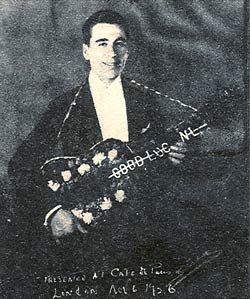 London, 1926
London, 1926
|
Almost overnight success and recognition came for Lucas after he began recording with Brunswick Records. During his career, he sold some 84 million discs, the bulk of them in the 1920's. His first big hit, "My Best Girl", was followed by a host of best-sellers including, "Adorable" , "Bye Bye Blackbird" , "The Song Is Ended" , "High High Up In The Hills" , "Together" , "In A Little Spanish Town" , "I'm Sitting On Top Of The World" , "Lady Play Your Mandolin" , "Side By Side" , "Somebody Stole My Gal" , and the two big production numbers from his first film, Gold Diggers Of Broadway, in 1929; "Tip-toe Through The Tulips With Me" ,and "Painting The Clouds With Sunshine".
When he visited London in 1926 he set new attendance records at the London Palladium, the Café de Paris and the Kit Kat Club. He also gave private recitals for the Prince of Wales and the Queen of Spain. Despite Nick's great success, he never performed again in Britain.
|
|
|
|
While appearing at the Orpheum Theater in Los Angeles in 1929, Lucas was signed by Warner Brothers to sing in their new color musical, Gold Diggers of Broadway. He was very impressed by the production number offered to him which was based on the song "Painting The Clouds With Sunshine" , written especially for the film. After the picture was in production Lucas was given a second big production number, "Tiptoe Through The Tulips With Me" . In that sequence the chorines actually danced through red and yellow tulips as Nick sang. "Tiptoe Through The Tulips With Me " sold three million copies in its initial pressing as a record, and since that time over five million more copies of the Lucas recording have been bought.
|
|
|
|
Warner Brothers so liked his screen image that they rushed him into Show of Shows in which he appeared in the "Chinese Fantasy" number singing "Li-Po-Li" to an Orientally-attired Myrna Loy.
The studio then offered the singer a seven-year contract which he refused. The contract went to Dick Powell. Lucas says he turned down the offer because he was happy making $3,000 a week in vaudeville and had bookings for two years in advance. At the time his agent did not see any great future for him as a movie star. He did return to films, however, in the late 1930's, starring in a series of shorts for both Universal and Warner Brothers. These musicals were made in Brooklyn with his orchestra. Later he also did a few shorts that were produced by James Roosevelt, but Lucas said they were not successful. |
Nick had already starred in two Broadway shows before coming to films: "Sweetheart Time" in 1926 (in which Irene Dunne was an understudy) , and "Show Girl" in 1929 with Ruby Keeler. Although the year 1929 brought Nick his biggest selling record it also brought the Great Depression which eventually killed Vaudeville and nearly did the same thing to the record industry. Nick's records, however, continued to be good sellers through 1931, when he left Brunswick over a dispute but he returned to them in 1932 after making a couple of recordings for the Hit of the Week label. Vaudeville, however, faded quickly and on November 16, 1932, Nick Lucas was the last act to headline New York City's famed Palace Theatre before it was completely converted to a movie house. Nick Lucas, however stayed active and during the 1930's starred in two radio programs, for NBC and Columbia (later CBS) , besides making forty or fifty sixteen-inch transcription records which were used as fillers by radio stations (he also made some more recordings for broadcasting in Canada) .
Lucas starred in short subjects for both Universal and Vitaphone (Warner Bros.). In What This Country Needs (1934), he performed "Tip Toe Through the Tulips," "Goody Goody," and "Sing and Old Fashioned Song," while in Vitaphone Headliners (1936) he crooned "Broken Hearted Troubadour." From 1936 to 1938, Lucas was the main vocalist with Al Pearce on CBS radio.
In 1938 Nick Lucas began appearing in night clubs, and performed in almost every major city in the United States and went on world tour. At the end of the tour in 1939 he appeared on the Tivoli theater circuit in Australia billed as 'The World Famous Star of Radio, Stage and Screen' and while in Sydney cut six sides for the Regal Zonophone label. He stayed in Australia for only six months due to the outbreak of the second World War. While in Melbourne he appeared on his own weekly radio program.
Back in America, Nick continued to work in clubs and on stage and made the short films Yankee Doodle Home (1939) and in Congamania (1940) he performed "In a Little Spanish Town." In 1944 Nick Lucas made four short films for the Soundies Corporation of America.
|
|
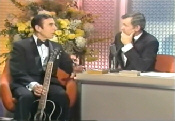
|
Congamania (1940)
|
Tonight Show (1969)
|
After a successful stand in Hawaii, Nick returned to Hollywood in 1947 and his long-time pal Ken Murray asked him to join his "Ken Murry Blackouts" at the El Capitan Theatre and he was such a success that he remained to headline the show for one-hundred consecutive weeks before going with it to Broadway in 1949. While in New York City he also made his national television debut with Ken Murry. He also made an apparance on Ed Sullivan's "Toast of the Town" show. In the early 1950's he moved to California, and resided in Hollywood and Hemet. While back in Hollywood he starred in seven television short films for the Snader Telescription Corporation as well as make a guest appearance as himself in the 1951 Allied Artists film Disc Jockey where he sang "Let's Meander Thru the Meadow". In 1951 he returned to network radio to star in the ABC series "Saturday Night at the Shamrock", which originated from the Shamrock Hotel in Houston, Texas.
He continued to make recordings for such labels as Diamond, Capitol, Cavalier, Accent, Decca and others. He had great success with his 1957 Decca LP, (DL8653) called Painting the Clouds with Sunshine. As the decade progressed he continued to headline top night spots all over the country with extended bookings each year in Reno and Las Vegas. In 1966 he starred in the stage revue "The Blackouts of 1966" at the Cal-Neva in Lake Tahoe. In the late 1960s Tiny Tim recorded "Tip Toe Through the Tulips" (sometimes dedicating it to the 'great Nick Lucas' when he performed the song) and this lead to a renewal of interest in Nick Lucas and the demand for personal appearances increased. In these later years he appeared on a number of American TV programs, including those of Lawrence Welk, Art Linkletter , Ed Sullivan, Merv Griffin and Johnny Carson.
In 1974 he sang "I'm Gonna Charleston Back To Charleston," "When You And I Were Seventeen," and "Five Foot Two, Eyes Of Blue" for the soundtrack of the Academy Award-winning Paramount re-make of The Great Gatsby, the following year providing similarly for the Oscar-nominated satire on Hollywood's early talkie era, The Day Of The Locust and also the film, Hearts Of The West.
The year 1980 opened with millions of TV viewers throughout the world seeing Nick Lucas riding in the Pasadena Rose Bowl Parade aboard a float appropriately called "Tip Toe Through The Tulips."
|
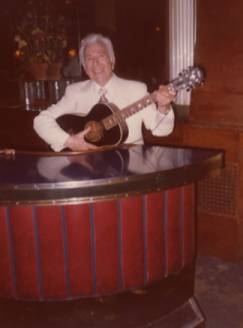 1981
1981
|
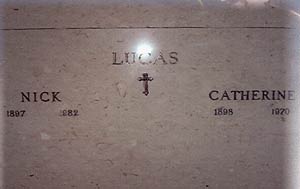 Tomb of Nick and his wife Catherine at the "Shrine Of Remembrance" Colorado Springs, Colorado
Tomb of Nick and his wife Catherine at the "Shrine Of Remembrance" Colorado Springs, Colorado
|
Nick Lucas' career in music began in 1915 in New Jersey and entertained until 1981 when age and illness forced him into retirement. Becoming ill he was hospitalized in Colorado Springs. Less than a month before his 85th birthday, Nick Lucas the "Crooning Troubadour" died at the age of 84 in Colorado Springs, Colorado July 28, 1982 of double pneumonia.
|
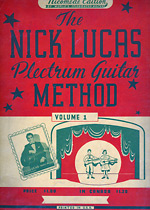
| The Nick Lucas Musician's Guild |
|
|
|
|
|
Sammy Stept - Piano / Celeste
|
|
Frank Lucanese - Accordian / Ukulele
|
| Thurman Teague - Acoustic Bass |
|
Bill Wiges - Piano
|
|
Roy Fox - trumpet
|
|
Charlie Lees - Vibes
|
| Reg Lewis - Piano |
|
|
| Jack Purvis - Trumpet |
|
Dick Freeman - Drums
|
|
Tommy Dorsey - Trombone
|
|
Charlie Fields - Guitar
|
|
|
|
Ted Fiorito - Piano
|
| Robert Armstrong - Piano |
|
Vincent Terri - Bass
|
|
Clifton Ellis - Clarinet
|
|
|
| Kentucky Five |
Lucas Ukulele Trio and Novelty Quartet
|
| Vernon Country Club Orchestra |
|
Russo-Fiorito Orchestra
|
|
ARC - Brunswick Studio Orchestra
|
|
Crooning Troubadours
|
| Victor Young Orchestra |
|
|
|
Maxwell Davis Orchestra
|
|
Lawrence Welk Orchestra
|
|
Sam Lanin Orchestra
|
|
Don Parker Trio
|
|
"..I began on simple chords like most everybody, and then I studied for a year on the Nick Lucas book."
-Joe Pass
"Me and my younger brother, John, used to listen to that record, "Picking The Guitar" and "Teasing The Frets." We'd play it over and over again. And boy, we'd say, "Can't that fellow play! Wow!!" "
-Merle Travis
If Lucas' 1922 disc made its way to the remote backwater of Rosewood, Kentucky, might not Jimmie Rodgers and Blind Lemon Jefferson also have heard it? Both men would record later in the 1920's, playing bass lines similar to Lucas'.
"I've been the luckiest guy in the world. If you disc jockeys had been on hand when Nick Lucas first hit his stride he'd be the biggest name in show business."
-Bing Crosby
"We fellows in the field of western music know that Nick Lucas pioneered with guitar music. He can do two of the old favorites and throw a blanket of nostalgia over any audience in America."
-Eddie Dean
"He didn’t like long rehersals. After going thru a song once, or twice at the most, he would record the master perfectly. Nick was one of the great artists in American pop music history."
-Scott Seely - Owner of Accent Records-July 3, 2004
"Then I got into flatpicking. I ordered a guitar from Sears and Roebuck, and there came a book with it with different little songs in there that you could flatpick. It showed the old-time jazz guitarist Nick Lucas; it showed how he held his pick. My youngest brother, David, showed me how Lucas held his pick, and that's how I learned to hold mine...."
-Doc Watson
|
Nick Lucas ~ ‘A Volume of Firsts’
Nick Lucas was the first to put a guitar into bands of the day. The first intimate crooner. The first 'guitar star', the first entertainer to make this instrument a part of his act; most others were using ukes and banjos.
The first in 1925 to have a guitar custom made in his name.(Before Gene Autry, who was a great admirer of Nick Lucas.) Gibson called it, The Gibson Nick Lucas Special. [Gibson still offers a Nick Lucas guitar.]
In 1924 Frank Campbell, who was general sales manager for Gibson was looking for an endorsement by a well-known star to push an expensive guitar. Nick Lucas, who had the first guitar instrumental hit record in 1922, [Picking The Guitar/Teasing The Frets (Pathe Actuelle 020794)] was an obvious choice, since he was already playing a Gibson L-5.
The first to have a guitar pick made with his name; Nick Lucas established and mastered the guitar pick. In the early 1930's Joe Nicomeda, a friend of Lugi D'Andrea (the first manufacture of guitar picks) worked out a deal with Lucas to make a flat pick. The finished product featured a stylized impression of Nick Lucas' name.... the first imprinted guitar pick.
It is also interesting that most of the photographs of guitarists, in the 1920's and 1930's sat down to play their instruments, while Nick Lucas was making practical use of the strap.......
His 1929 # 1 smash hit recording of ‘Tip-Toe Through The Tulips With Me’,[Brunswick 4418], was among the first recordings to sell over two million disks, as did its sheet music.
With his 1947 re-recording of 'Side By Side' on Capitol Records,[Capitol 15242], Nick Lucas was among the first to record his voice over multiple tracks to create his own harmonies, a technique now called dubbing or multi-track recording.
As historian Michael R. Pitts noted, "Nick Lucas' long and illustrious show business career was filled with so many "firsts" that it would take a large volume to do him justice."
.
|
|
|